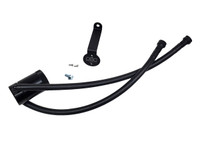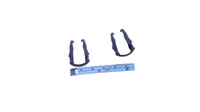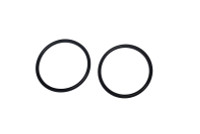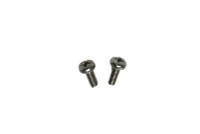Two replacement grey clip retainers for J&L OSC oil separator fittings. Please note the face of these clips is 3/8" wide, if your clips are GREEN or 1/4" wide please see this link for your correct replacements - https://www.jlosc.com/jl-replacement-pcv-fitting-green-clips-2/
If you have broken these clips be sure you are removing your fittings correctly, the clip should NOT be removed to release the fitting. Rather you should push in the larger portion of the clip inward to release. It's a button!
These clips fit the Ford, Dodge, Jeep and Ram kits!
Have questions if this part is right for you? Email info@jlosc.com
5 Reviews Hide Reviews Show Reviews
-
Catch can clips
Worked perfect just kinda high for 2 clips
-
J&L REPLACEMENT PCV FITTING GREY CLIPS (2) LARGE
Fast shipping, easy to install and replace projects clips.
-
Clips
Glad to get these. The ones on my truck broke cause they were brittle.
Glad you guys carried these. Thanks for saving me! -
Perfect replacement!
Although it was still working great after 5 years, I decided it was about time to finally clean my Seperator. After all this time I had forgotten that the clips were push to release and pried the first one off with a screwdriver. I broke it! These were a perfect replacement and a cure for my stupidity. Back in business for...another 5 years? ;-)
Related Product Videos
Inside the oil separator there is a filter. The filtered side of the can should always go to the PCV valve or “dirty” connection. The filter is what turns the oil vapor into liquid form to be collected in the basin of the unit. You want this to happen as it is entering the can. The open port will run to your intake.
In most cases you only need an oil separator on the PCV side (dirty side) of the engine. This is the side that is under vacuum/suction most of the time while the vehicle is running and driving. The clean side typically is only used for venting when the PCV valve is closed which is under moderate to high acceleration.
Some turbo vehicles can see oil in the clean side, such as Ecoboost F-150’s when they are exposed to frequent towing conditions.
On non-turbo applications anything short of road course racing you typically will not see a drop of collection out of the clean side.
For most Ford applications there is a grey or green tab, you press in this larger tab. It is a button; it will release the fitting and you pull up on the fitting with the button pressed. ***DO NOT REMOVE THE CLIPS FROM THE FITTING! YOU WILL BREAK THEM!!***
For GMC/Chevy applications there is a single button release. This release and the location of some of these fittings can be tricky. You must press the bottom squarely and pull the fitting straight off. Many people make the mistake of pressing the button too hard and it flexes the release. Take your time and it will release. The 5.3L intake fittings are the toughest due to their location.
Most applications average about an ounce of oil every thousand miles. However, there are many factors in collection rate as every single engine is different. Factors such as driving style, climate, engine condition, oil level all vary and effect collection rate.
People in cold climates will have to check their oil separator more often in the winter months due to condensation build up occurring in the oil separator itself. In these months, the air entering the can is significantly hotter than the ambient air temp. This results in condensation build up (think hot shower in a cold bathroom).
We recommend everyone to check their oil separator at 500-1000 miles of driving to get an idea of how often it needs to be serviced. The can holds 3 ounces without the optional extension.
Your J&L Oil Separator is Guaranteed for Life! Click here for more details on your J&L Oil Separator Co. Warranty
Every 15K+ Miles you will want to thoroughly clean the oil separator, Click here to view the How-To video
The specs on the screws are M4 x .7 x 10mm, they can be found at just about any hardware store.
Sometimes when the oil separator is over tightened it can be tough to remove; also some oil separators are much more accessible once installed than others.
If you are having trouble removing the oil separator reservoir, try removing it from the bracket or even vehicle to get a better grip on it. For units that are really tough, we recommend a rubber oil filter strap wrench. You can use this in combination with a rag and typically remove them without damage.
When reinstalling the can bottom, treat it like an oil filter. Screw the can to the bottom of the O-ring. Give it another ¾ to 1 full turn. No more, no less.
No! Dispose of this nasty oil that is mixed with fuel, water and everything else where you would dispose of your oil change oil. Many auto parts stores will take your old oil for free of charge.
If you read the fine print on any warranty contract you will find a lot of reasons your warranty can become void; installing aftermarket parts can be one of them.
However, per the Magnuson–Moss Warranty Act proof would have to be provided that the after-market part caused the failure.
If you need further clarification, contact your vehicles service department. Some are easier to deal with than others.
You will receive automated emails through our website when an order is placed and when the status is changed.
Gmail users will often find these emails under the “promotional tab”.
Yahoo users will often find all our order updates in their spam/junk folder.
When your order ships you will often get emails from the shipping service with tracking, your order in your customer portal will also have the tracking information.
Please be sure to check these folders prior to contacting us for further updates.
You can view our Return Policy by Clicking Here
We primarily use USPS and UPS for our shipping services, if you require expedited shipping or specific service please call 757-842-6497 to place your order or to get shipping quotes.
Small items such as replacement parts typically ship USPS First class mail.
Canadian orders placed through the website all ship USPS Priority International.

























